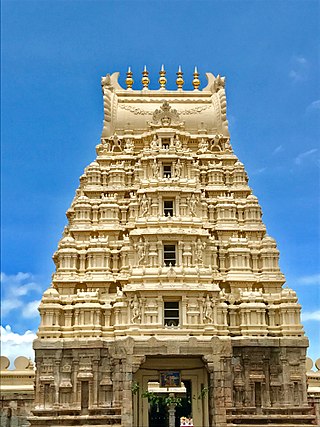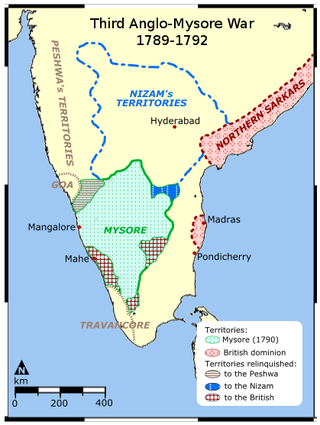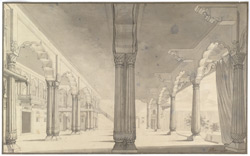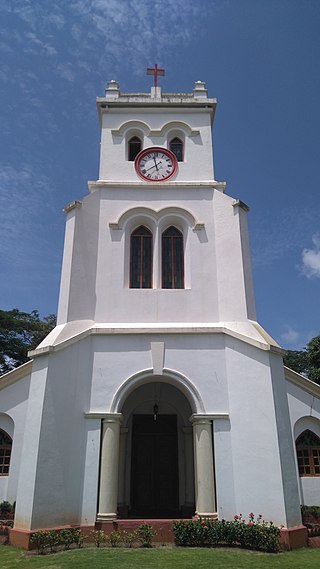
Srirangapatna is a town and headquarters of one of the seven Taluks of Mandya district, in the Indian State of Karnataka. It gets its name from the Ranganthaswamy temple consecrated around AD 984. Later, under the British rule, the city was renamed to Seringapatnam. Located near the city of Mandya, it is of religious, cultural and historic importance.

The Third Anglo-Mysore War (1790–1792) was a conflict in South India between the Kingdom of Mysore and the British East India Company, the Kingdom of Travancore, the Maratha Confederacy, and the Nizam of Hyderabad. It was the third of four Anglo-Mysore Wars.
The Bangalore Cantonment (1806–1881) was a military cantonment of the British Raj based in the Indian city of Bangalore. The cantonment covered an area of 13 square miles (34 km2), extending from the Residency on the west to Binnamangala on the east and from the Tanneries on Tannery Road in the north to AGRAM in the south. By area, it was the largest British military cantonment in South India. The British garrison stationed in the cantonment included three artillery batteries, and regiments of the cavalry, infantry, sappers, miners, mounted infantry, supply and transport corps and the Bangalore Rifle Volunteers. The Bangalore Cantonment was directly under the administration of the British Raj, while Bangalore City itself was under the jurisdiction of the Durbar of the Kingdom of Mysore.

Vani Vilas Women and Children Hospital is a government run hospital in Bangalore, Karnataka, India. It is attached to the Bangalore Medical College and Research Institute.

C.S.I. St. Mary's Church is the Anglican church located at Fort St George in Chennai, Tamil Nadu, India. It lies East of Suez and also the oldest British building in India. The church is popularly known as 'Westminster Abbey of the East'.

Bangalore Fort began in 1537 as a mud fort. The builder was Kempe Gowda I, a vassal of the Vijaynagar Empire and the founder of Bangalore. Hyder Ali in 1761 replaced the mud fort with a stone fort and it was further improved by his son Tipu Sultan in the late 18th century. It was damaged during an Anglo-Mysore war in 1791. It still remains a good example of 18th-century military fortification. The army of the British East India Company, led by Lord Cornwallis on 21 March 1791 captured the fort in the siege of Bangalore during the Third Mysore War (1790–1792). At the time the fort was a stronghold for Tipu Sultan. Today, the fort's Delhi gate, on Krishnarajendra Road, and two bastions are the primary remains of the fort. A marble plaque commemorates the spot where the British breached fort's wall, leading to its capture. The old fort area also includes Tipu Sultan's Summer Palace, and his armoury. The fort has provided the setting for the treasure hunt in the book Riddle of the Seventh Stone.

Tipu Sultan's Summer Palace, in Bangalore, India, is an example of Indo-Islamic architecture and was the summer residence of the Mysorean ruler Tipu Sultan. Hyder Ali commenced its construction within the walls of the Bangalore Fort, and it was completed during the reign of Tipu Sultan in 1791. After Tipu Sultan's death in the Fourth Anglo-Mysore War, the British Administration used the palace for its secretariat before moving to Attara Kacheri in 1868. Today the Archaeological Survey of India maintains the palace, which is located at the center of Old Bangalore near the Kalasipalya bus stand, as a tourist spot. Entry fee is ₹20 for Indian citizens, while for foreign visitors is ₹200 (US$2.50).

The siege of Bangalore was a siege of the town and fortifications of Bangalore during the Third Anglo-Mysore War by forces of the British East India Company, led by Charles, Earl Cornwallis against a Mysorean garrison, while Tipu Sultan, Mysore's ruler, harried the camps and positions of the besiegers. Arriving before the town on 5 February 1791, Cornwallis captured the town by assault on 7 February, and after six weeks of siege, stormed the fortress on 21 March.
The Karnataka Central Diocese is one of the twenty-two dioceses of the Church of South India covering the central part of Karnataka.
Murphy Town or Knoxpete, is a suburb located near Bangalore Cantonment, India. It is one of the oldest planned suburbs of the Cantonment, and was earlier known as Knoxpete, and was later changed to Hoysala Nagar. It is located North of Halasuru, with Murphy Road running along its periphery, and is also bounded by Old Madras Road and Kensington Road, with part of Kensington Road overlooking Halasuru Lake Madras Sappers.
Fraser Town, Bengaluru or Mootocherry, is a locality of Bangalore Cantonment, located in the central part of the city spread over 4 km2. It was established in 1906 and is named after Stuart Mitford Fraser (1864–1963), who was the tutor and guardian of Krishna Raja Wadiyar IV, Maharaja of Mysore. Fraser Town was established to de-congest the growing Bangalore Civil and Military Station. The foundation of Fraser Town was laid in August 1910 by Mrs. F J Richards, with a commemorative plaque on the corner of Coles Road and Mosque Road.
Cox Town, Bengaluru is a neighborhood of the Bangalore Cantonment, located in the central part of the city and named after the last Collector and District Magistrate of the Bangalore Civil and Military Station, Alexander Ranken Cox, Indian Civil Services. It is one of the suburbs which came out of the plan to de-congest thickly populated areas of the Bangalore Cantonment after the bubonic plague. Agricultural fields were converted for this purpose, and town was planned according to modern hygienic standards, with drainage and conservancy conveniences. Sarvagnanagara is bound by the Bangalore-Madras Railway line on the North and East, Wheeler Road in the East and the Ulsoor Polo Ground in the South. It consists of posh localities like Heerachand Layout and other localities like Sindhi Colony, Jeevanahalli, Doddigunta, and roads such as Assaye Road, Charles Campbell Road, Wheeler Road, etc. and is adjoining the suburbs of Pulakeshi Nagara, Sri Krishnaraja Wadiyar Nagara and Cooke Town, with easy access to the Bengaluru East Railway Station, Halasuru, Lingarajapura, Shivajinagara. Sarvagnanagara is a well planned, posh and preferred locality in the Bangalore Cantonment, created during the British Raj. The residents of Sarvagnanagara follow a liberal 'live a let live' attitude, with suburb still retaining much of its green cover, without excessive commercialisation. In 1988, the BBMP renamed Cox Town as Sarvagnanagara, after a 16th-century saint poet.
St. Andrew's Church, consecrated in 1866, is a Presbyterian church, located on Cubbon Road, Bangalore. Initially knows as St. Andrews's Kirk, it was a Church of Scotland church till 1959 when it became part of the Karnataka Central Diocese of the Church of South India. The church is named after Saint Andrew, the patron saint of Scotland. St Andrew's Church celebrated its 150 years anniversary on 20 November 2014.

St. Bartholomew's Church is an Anglican church, built by the Madras Government for the East India Company troops stationed in Kingdom of Mysore and is located in Lashkar Mohalla, on the Nilgiri Road, near the noisy Mysore sub-urban bus stand in Mysore City. The church grounds was consecrated on 29 November 1830 by Bishop Turner of Calcutta, (p. 327) and the building was completed in 1832. The church is named after Saint Bartholomew, one of the 12 apostles of Jesus Christ, and is said to have visited India in the first century AD, and preached the Christian gospel in the Kalyan, Thane and Raigad regions of present-day Maharashtra.

Garrison Cemetery is located in Seringapatam, on the banks of the river Cauvery, about 300m from the Bangalore Mysore Highway. It has about 307 graves of the European officers killed in the final assault on Tippu Sultan in 1799, and their family members. Among the graves, there are 80 graves of the officers of the Swiss ‘de Meuron Regiment’, and the rest of the graves are their family members.

St. Paul's Church is an Anglican church in Mangalore, India.
The Rice Memorial Church is located in the busy Avenue Road, Bangalore Pete. It is named after Rev. Benjamin Holt Rice, a missionary of the London Missionary Society (LMS), a Canarese scholar and a pioneer of education in the Bangalore Pete region. The Rice Memorial Church stands on a busy street in the midst of temple, dargahs, book shops and heavy traffic, with its colonial British structure appearing to be out of place in the traditional Bangalore market district. The church stands on the site of the London Mission Canarese Chapel built by Rev. Rice, which itself was built on the site of the first Canarese chapel built by William Campbell in 1834. The church is a stone building in the European Classical style, with Tuscan columns, pediments and keystone arch windows. The church building has been demolished and raised at least 3 times, with the current structure consecrated in 1917.

Thomas Hodson was a Wesleyan Missionary, who served in India, in the Wesleyan Canarese Mission, at the Bangalore Petah and Gubbi. He helped in running the first Wesleyan Mission Canarese school in the erstwhile Mysore State. Hodson was a linguist and a Kannada scholar, and was also fluent in Tamil and Bengali. He helped in establishing the Wesleyan Canarese Chapel at Nagarthpete in the Bangalore Petah. In 1864, Hodson wrote An Elementary Grammar of the Kannada, or Canarese Language, a treatise on the grammar of the Kannada language.
James Hunter (1755–1792) served as a lieutenant in the Royal Artillery in British India, serving under Marquess Cornwallis. Hunter worked as a military artist, and his sketches portray aspects of military and everyday life. Hunter took part in Tippu Sultan campaigns and other military campaigns in South India. His paintings provide a picture of late-18th-century life in South India.

Sree Ramaseva Mandali is an 80 years old cultural organisation known for organising Indian Classical Music Festivals as part of its Rama Navami celebrations at Chamrajpet, Bangalore. The organisation was founded in the year 1939 by Sri S.V.Narayanaswamy Rao at the age of 14.
















